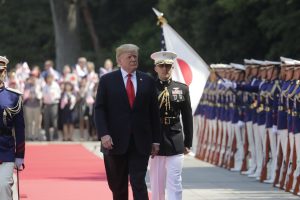The French philosopher Albert Camus once wrote, “In the middle of winter, I at last discovered that there was in me an invincible summer.” He may as well have been describing U.S. alliances in East Asia after nearly four years of the Donald Trump administration. Despite weathering tremendous challenges, U.S. alliances with Australia, Japan, the Philippines, and South Korea have proven to be more resilient than many would have expected.
The Trump administration’s approach to traditional allies in Asia can be characterized by two disparate — and contradictory — impulses: A view that deeper cooperation between the United States and its allies will be critical amid deepening competition with China, and a unilateralist impulse that is highly skeptical about the value and fairness of alliances. This dichotomy has resulted in a chaotic approach, in which the United States has demanded that allies align closer to U.S. policies on China while Washington has concurrently engaged in a series of tit-for-tat trade disputes with the same allies, requested significant increases of payments to offset U.S. costs, and threatened to withdraw U.S. forces and abrogate security commitments.
After nearly four years in office, a U.S. administration that promised to be disruptive has certainly lived up to that expectation. President Trump’s deep misgivings about the value of alliances has been a consistent feature of his expressed worldview for nearly three decades, and his policies have rattled U.S. alliances in East Asia to a degree unseen for more than 40 years. Yet Trump’s record on East Asian alliances has included some bright spots as well. After four years these alliances have certainly been damaged, but they have also demonstrated significant resilience.
Chaos and Clarity
The Trump administration’s approach to the Indo-Pacific has been defined by articulated statements of policy intent that were soon followed by other clear statements of entirely different policy intentions. Implementation of policies has been haphazard and inconsistent, reflecting the inconsistency of the policies themselves as well as the president’s strategic unpredictability.
Across its nearly four years in power, the Trump administration has been on both sides of most critical issues in the geopolitics of the Indo-Pacific, from relations with China and North Korea to human rights. On the role of alliances in particular, Trump has described U.S. allies as taking advantage of the United States and complained they would not come to America’s aid. By contrast, his National Defense Strategy called alliances “the backbone of global security” and the White House’s “Strategic Approach to the PRC” identified the top U.S. priority as “improv[ing] the resiliency of our institutions, alliances, and partnerships.”
Such inconsistency has driven deep anxieties in the minds of U.S. allies and partners across the Indo-Pacific. According to the nonpartisan Pew Research Center, the percentage of people in Japan and Australia with a positive view of the United States has plummeted to 41 percent and 33 percent, respectively – record lows. These plummeting levels of support can be attributed to broad public perceptions ranking the U.S. response to the COVID-19 pandemic as lowest in the world, and a lack of confidence in Trump, specifically. For example, South Korea’s confidence in Trump in 2020 was at 17 percent, compared to 88 percent for then-President Barack Obama in 2016. Overall, the majority of people in Japan and Australia have an unfavorable opinion of the United States (54 percent and 64 percent, respectively), while South Korea’s view of the United States has remained generally positive (an unfavorable rating of 39 percent).
These concerns have also percolated among allied foreign policy leaders and bureaucracies. Several U.S. allies have increased spending on defense as they considered the implications of a less reliable United States, and Japan’s pursuit of offensive strike capabilities was reportedly driven by fears of the continued deterioration of its alliance with the United States. Additionally, Japan’s push for like-minded countries to sign on to the Comprehensive and Progressive Agreement for Trans-Partnership (CPTPP) arose after the United States withdrew from the Trans-Pacific Partnership (TPP). Similarly, the Trump administration’s lack of leadership in international institutions raised concerns that the United States was no longer interested in leading the world and setting the international agenda, thus creating a geopolitical vacuum for China to fill.
Yet there have been other aspects of the Trump administration’s approach to the Indo-Pacific that some allied and partner foreign policy experts have supported. Specifically, the Trump administration’s willingness to explicitly accept friction with Beijing in the pursuit of U.S. interests has been welcomed by those in Japan and elsewhere with a more hawkish view of China. Recently, an anonymous official from Japan’s Foreign Ministry writing for the American Interest also saw advantages from Trump’s approach – clarity mixed with chaos – especially when compared to what the official saw as a more conciliatory Obama administration strategy. “[H]aving a poorly implemented but fundamentally correct strategy [under Trump] is better than having a well-implemented but ambiguous strategy [under Obama],” the official wrote. As James Crabtree highlighted in Foreign Policy, similar opinions have been expressed by scholars and officials from Singapore, India, and Taiwan.

































